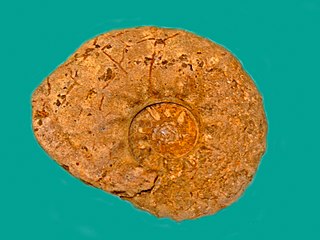
Australiceras is an extinct ammonite genus from the upper part of the Early Cretaceous, Aptian stage, included in the family Ancyloceratidae.

Xipheroceras is a Lower Jurassic ammonite belonging to the Eoderoceratidae, and sometimes placed in the subfamily Xipheroceratinae for which it is the namesake. It has been found in the upper Sinemurian of Europe and possibly Borneo.

Aspidoceras is an extinct ammonoid cephalopod genus belonging to the family Aspidoceratidae.
Astiericeras is an ammonite from the Lower Cretaceous, the shell of which is evolute, stout; outer whorl with strong, well spaced, transverse ribs that cross smoothly over the broad venter; early whorls with lateral tubercles. The outer, mature whorl separates from the coil but hooks back quickly, referred to as a heteromorph.

Barroisiceras is an acanthoceratacean ammonite from the Upper Cretaceous, Coniacian, included in the family Collignoniceratidae.
Benacoceras is a strongly ribbed, evolute ammonite from the Late Jurassic, coiled so that all whorls are exposed. Ribbing is biplicate, with very short secondaries. The venter, the outer rim, is smooth, at least on the outer whorl.
Bradfordia is a moderately involute to involute genus included in the ammonoid cephalopod family Oppeliidae, coiled so that the outer whorl encloses most, or much, of the previous, but with a small umbilicus exposing inner whorls. The shell is compressed, whorl height much greater than width, extending well out from the contact with the adjacent inner whorl. Outer flanks are finely ribbed and the rounded venter is smooth.
Euaptetoceras is an evolute hildoceratoid ammonite from the lower Middle Jurassic, included in the family Hammatoceratidae and the subfamility Hammatoceratinae. The genus may be a junior synonym for Eudmetoceras of Buckman, 1920.
Oecotraustes is an extinct cephalopod genus included in the ammonid family Oppeliidae and named by Waagen in 1869. The genus lived during the Middle Jurassic.
Oecoptychius is an extinct genus of fossil ammonite cephalopods. The species lived during the Middle Jurassic.
Tylonautilus is an extinct genus in the nautiloid order Nautilida from the Lower Carboniferous of Europe and Permian of Japan.

Peltoceras is an extinct ammonite genus from the aspidoceratid subfamily Peltoceratinae that lived during the later part of the Middle Jurassic.
Neoptychites is an extinct ammonoid cephalopod genus from the Turonian stage of the Upper Cretaceous, with a worldwide distribution.
Eoderoceras is an evolute, round whorled ammonite from the Lower Jurassic with an outer row of distinct spines, and in some, an inner row of tubercles, on either side; ribs only on the inner whorls.

Hauericeras is an ammonite genus from the Late Cretaceous that lived from the Coniacian to the late Maastrichtian, from about 90 to 66 mya. Fossils have been found in Europe, Russia, South Africa, Australia, India, Iraq, and in the United States.
Melchiorites is a desmoceratid ammonite genus included in the subfamily Puzosiinae. Member species are characterized by an essentially evolute shell in which the early whorls are smooth, with sinuous radial or oblique constrictions but in which later whorls have feeble intermediate ribs on the outer part of the sides and venter.
Dayiceras is a finely ribbed polymorphitid eoderoceratacean ammonoid cephalopod from the Jurassic, named by Spath in 1920. The shell is evolute, coiled such that all whorls are exposed. The whorl section is compressed such as to be higher than wide. A row of fine tubercles runs along the middle of the outer rim, the venter.

Harpoceras is an extinct genus of ammonite belonging to the family Hildoceratidae. These cephalopods existed in the Jurassic period, during the Toarcian age from the Falciferum zone to the Commune subzone of the Bifrons zone. They were fast-moving nektonic carnivores.
Palaeophyllites is a genus of ammonoids from the Lower Triassic and a contemporary of the related ussuritid Eophyllites.
Radstockiceras is an extinct genus of lower Jurassic ammonite that lived from Oxynotum zone of upper Sinemurian to Raricostatum zone of lower Pliensbachian. Shells of these animals were oxycone and involute with umbilicus that took maximum of 12% of diameter in the case of outer whorls. On inner whorls, venter has been sharp, but then it became rounded. Faint ribs had falcoid shape, but sometimes, ribs could absent. Shells could have been large in their size. Suture has been very complex, similar to Oxynoticeras, but culmination at umbilical margin has been missing. Genus has been named after town of Radstock, in Somerset.






